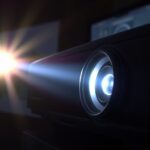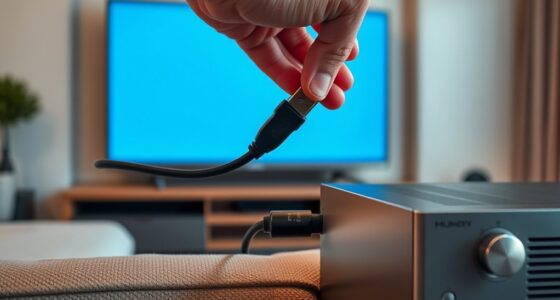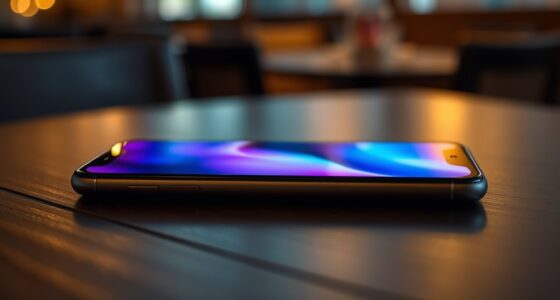When choosing a projector, key specs like brightness, contrast ratio, resolution, and light source determine image quality and performance. Brightness, measured in lumens, affects visibility in various lighting conditions, while contrast ratio influences color vibrancy and depth. Resolution impacts sharpness, especially on larger screens. Light source type and lamp life affect longevity and maintenance. Features like keystone correction, connectivity options, and portability help optimize setup. Continue exploring to fully understand these essential projector details.
Key Takeaways
- Brightness (Lumens): Measures the light output; higher lumens suit well-lit environments, ensuring clearer images.
- Contrast Ratio: Indicates the difference between black and white levels; higher ratios produce more vibrant, detailed images.
- Resolution: Defines the pixel count; higher resolution (e.g., 1080p, 4K) results in sharper, clearer visuals.
- Light Source Type: Includes lamp, LED, and laser; affects image brightness, lifespan, energy efficiency, and maintenance needs.
- Throw Ratio & Distance: Determines the projector’s placement relative to the screen; influences image size and room setup.
Brightness (Lumens)

Have you ever wondered how bright a projector needs to be to display clear images in your space? Brightness, measured in lumens, directly affects your projector’s visibility. When considering projection placement and projector positioning, higher lumens ensure your images stay sharp and vibrant, even in well-lit rooms. If your space has ambient light, you’ll want a projector with at least 2,500 lumens; for darker rooms, fewer lumens may suffice. Proper projection placement helps optimize brightness, so the image isn’t washed out or too dim. Additionally, the room size and the amount of ambient light play crucial roles in determining the necessary lumen level for clear visuals. Keep in mind that the closer or farther your projector is from the screen, the more you’ll need to account for brightness levels. Selecting a projector with appropriate lumens is a crucial factor in achieving optimal image quality and ensuring your visuals are clear and engaging, no matter your room’s lighting conditions. Understanding how brightness levels impact visibility can help you make better projector choices for different environments, especially as industry transformations continue to influence available technology. A thorough understanding of essential specifications can also aid in selecting the right projector for your needs.
Contrast Ratio

Contrast ratio measures the difference between the darkest blacks and brightest whites a projector can produce. It’s a key factor in determining how vivid and detailed your images appear. Understanding this ratio helps you choose the right projector for your specific needs. Higher contrast ratios generally result in more vibrant and dynamic images, especially in darker viewing environments. Additionally, the contrast ratio can be affected by the projector’s technology, such as LCD or DLP, which impacts overall image rendering. As technology advances, improvements in contrast ratio are expected to further enhance visual clarity and viewing realism. Moreover, a higher contrast ratio enhances image quality by providing better depth and dimension to the displayed content. This metric is essential for achieving a cinematic experience in home theaters and professional presentations alike.
Subheading 1: Definition and Significance
Understanding the contrast ratio is essential because it directly affects the clarity and vividness of the images projected. It measures the difference between the darkest black and the brightest white a projector can produce, which impacts how realistic and sharp your images appear. This spec is closely tied to projection technology, influencing how well details are rendered in different lighting conditions. A higher contrast ratio generally means deeper blacks and more vibrant colors, enhancing overall image quality. Additionally, contrast ratio plays a role in projector ergonomics, as a device with a good contrast ratio can operate effectively in various environments without extra adjustments. Knowing this helps you select a projector that delivers clear, dynamic visuals suitable for your specific viewing needs. Moreover, understanding the digital literacy of your audience can help you choose a projector with optimal contrast for presentations and multimedia content in various settings. A comprehensive grasp of contrast ratio can also guide you in matching a projector to the ambient lighting of your environment for the best viewing experience. Considering the environmental factors where the projector will be used can further optimize image quality and viewer satisfaction. In the context of AI security, advancements in projection technology are increasingly being integrated with AI systems to improve display accuracy and user interaction. Recognizing the importance of projection technology can help you select a device that meets both current and future display demands.
Subheading 2: How Contrast Ratio Affects Image Quality
The contrast ratio directly influences how vivid and detailed your projected images appear. A higher contrast ratio means darker blacks and brighter whites, making images pop with clarity. This enhances overall image quality, especially in rooms with ambient light. When adjusting projection keystone or lens shift, maintaining good contrast helps prevent image distortion and loss of detail. A low contrast ratio can make shadows look flat and colors less vibrant, reducing the visual impact. If your projector allows for lens shift adjustments, a higher contrast ratio ensures these modifications don’t compromise image depth or clarity. Remember, contrast ratio impacts how well you perceive fine details and color richness, directly affecting your viewing experience. Additionally, a good contrast ratio can help mitigate some issues caused by environmental lighting, ensuring your images remain vibrant and clear regardless of ambient conditions. As cyber threats evolve, AI security plays a vital role in maintaining the integrity and quality of digital content, including projections and displays. Moreover, understanding projection specifications like contrast ratio can assist you in selecting the best device for your specific environment and viewing needs.
Furthermore, selecting a projector with an appropriate contrast ratio is essential for effective viewing in various settings, whether in a home theater, classroom, or outdoor environment.
Subheading 3: Ideal Contrast Ratios for Uses
Choosing the right contrast ratio depends on how you’ll use your projector. For rooms with ambient lighting, like living rooms or casual spaces, aim for a contrast ratio of at least 10,000:1 to guarantee bright images and good detail. In darker environments, such as home theaters, lower ratios like 3,000:1 can still produce vivid images, since ambient light isn’t a concern. Room size also matters: larger rooms with more ambient light require higher contrast ratios to maintain image clarity and depth. Additionally, room lighting conditions play a crucial role in selecting the optimal contrast ratio, as they directly impact the perceived image quality. Incorporating projector placement considerations can further enhance image contrast and overall viewing experience. Properly managing ambient light can significantly improve contrast performance, especially in versatile viewing environments. Conversely, smaller, controlled environments allow for lower ratios without sacrificing quality. Ultimately, matching the contrast ratio to your room’s lighting conditions and size assures you get clear, sharp visuals tailored to your specific use. Additionally, understanding lighting conditions in your space helps determine the optimal contrast ratio for the best viewing experience.
Resolution

Understanding resolution is key to getting sharp, clear images from your projector. You should know the difference between native and supported resolution to guarantee compatibility and quality. Additionally, consider aspect ratio choices to match your content for the best viewing experience.
Native vs. Supported Resolution
When evaluating projector resolutions, it’s important to distinguish between native and supported resolutions. Your projector’s native resolution is the actual number of pixels on its imaging chip, directly affecting image clarity and sharpness. Supported resolution refers to the maximum resolution the projector can accept from an input device, which might be higher than the native resolution. This distinction matters because if you connect a device with a higher supported resolution, the projector will downscale the image to its native resolution, potentially impacting clarity. Also, consider your screen size and throw distance: larger screens and longer throw distances may require higher resolutions to maintain image quality. Understanding this difference helps you choose a projector that matches your setup and guarantees *ideal* image performance.
Resolution and Image Clarity
Resolution directly impacts the clarity and detail of your projected image. Higher resolutions, like 1080p or 4K, guarantee sharper visuals, especially when you use lens zoom features to adjust the image size without losing quality. Keep in mind that a projector with better resolution offers more detail, making text and images appear crisp. Additionally, some projectors include audio output options, which allow you to connect external speakers for clearer sound, enhancing your overall viewing experience. When selecting a projector, consider how resolution affects both image sharpness and clarity, especially if you plan to display detailed content or large images. Balancing resolution with features like lens zoom and audio output ensures your setup delivers both sharp visuals and quality sound.
Aspect Ratio Considerations
Choosing the right aspect ratio is key to optimizing your projector’s resolution for different types of content. Understanding aspect ratio nuances helps you select a display that fits your needs, whether for movies, presentations, or gaming. A standard 16:9 ratio suits most modern media, providing broad aspect ratio flexibility for widescreen content. However, if you’re projecting in a more cinematic style, a 2.35:1 ratio offers a wider view. Keep in mind that some projectors support adjustable aspect ratios, allowing you to switch between formats without losing image quality. This aspect ratio flexibility guarantees you get the best possible picture for each application, avoiding distortion or black bars. By considering aspect ratio nuances, you optimize your viewing experience and make the most of your projector’s resolution capabilities.
Throw Distance and Throw Ratio

Understanding throw distance and throw ratio is essential for selecting the right projector for your space. Throw distance is the space between your projector and the screen, impacting how large the image will be. The throw ratio is a simple calculation: it’s the ratio of the throw distance to the image width. A low throw ratio (like 0.5:1) means you can place the projector closer to the screen for a larger image, ideal for small rooms. A high throw ratio (like 2:1) requires more distance for the same image size, suited for bigger venues. Knowing your room’s dimensions helps you choose a projector with the right throw distance and ratio, ensuring a clear, appropriately sized image without needing excessive space or adjustments.
Light Source and Lamp Life

Your projector’s light source determines how bright your image appears and how long it will last. Knowing the lamp life expectancy and the different types of light sources helps you plan for replacements and maintenance. Brightness, measured in lumens, also affects how well the image can be seen in various lighting conditions.
Lamp Life Expectancy
Ever wonder how long a projector’s light source will last before it needs replacing? Lamp life expectancy refers to the duration your projector’s lamp maintains peak brightness, directly impacting lamp longevity and bulb durability. Most projectors specify this in hours, typically ranging from 1,500 to 20,000 hours, depending on the technology. Longer lamp life means fewer replacements and lower maintenance costs. Keep in mind that actual lifespan can vary based on usage patterns, brightness settings, and environmental conditions. To maximize your projector’s lifespan, follow manufacturer guidelines and avoid running the lamp at maximum brightness constantly. Knowing the expected lamp life helps you plan for replacements and ensures you get the most out of your projector’s bulb durability over time.
Light Source Types
Different types of light sources in projectors considerably influence lamp life and overall performance. Your choice of light source types affects durability, maintenance, and image quality.
- Lamp-based projectors typically use traditional bulbs that need replacement after about 2,000 to 4,000 hours. They tend to be more affordable upfront.
- LED projectors use light-emitting diodes, offering longer lifespan—often over 20,000 hours—and lower maintenance.
- Laser projectors combine the best of both worlds, with extended lamp life and bright, consistent images.
When comparing lamp versus LED, LED sources are more energy-efficient and durable, making them ideal for long-term use. Your decision impacts both initial costs and ongoing upkeep.
Brightness and Lumens
How bright a projector appears depends largely on its lumens rating, which measures its light output. Higher lumens mean a brighter image, essential for effective projection placement in well-lit rooms. If you plan to use the projector in a dark room, lower lumens might suffice, helping you save energy and extend lamp life. Brightness impacts both image clarity and energy efficiency, so choosing the right lumens for your environment is key. Be mindful that higher brightness often results in increased power consumption and potentially shorter lamp life. Conversely, a projector with lower lumens can be more energy-efficient, but may struggle in bright settings. Balancing brightness and energy use ensures ideal projection quality and cost savings over time.
Color Accuracy and Color Gamut

When evaluating a projector, understanding its color accuracy and color gamut is essential because these specs directly affect how vibrant and true-to-life the images appear. Good color calibration guarantees the colors match their real-world counterparts, while a broad color gamut allows for more vivid and diverse hues. To assess these qualities, look for projectors that offer high color saturation, which makes images pop without oversaturating. Keep in mind:
- Precise color calibration for consistent output
- Wide color gamut for richer, more accurate colors
- High color saturation for vibrant visuals
These factors ensure your images are not only bright but also true to life, making your viewing experience immersive and visually appealing. Prioritizing color accuracy and gamut helps you achieve professional-quality images in any setting.
Keystone Correction and Lens Shift

Keystone correction and lens shift are essential tools for optimizing your projected image, especially when your projector cannot be perfectly aligned with the screen. Keystone correction adjusts the image digitally to fix trapezoidal distortion, while lens shift moves the lens itself to reposition the image without distortion. These features help you achieve a clear, rectangular display, even if the projector is placed off-center or at an angle.
| Feature | Function | Benefits |
|---|---|---|
| Keystone correction | Digital adjustment of image shape | Corrects trapezoidal distortion |
| Lens shift | Physical movement of the lens for image position | Maintains image quality without distortion |
Connectivity Options

Connectivity options determine how easily you can connect your projector to various devices and sources. Whether you prefer wireless connectivity or wired options, choosing the right setup guarantees smooth, hassle-free use. Wireless connectivity allows you to stream content from laptops, smartphones, or tablets without clutter or cables. Wired options, like HDMI, VGA, or USB ports, provide a stable connection for high-quality video and audio.
Choose between wireless streaming or wired connections for seamless, versatile projector setup.
Look for projectors with multiple connectivity choices, such as:
- Built-in Wi-Fi or Bluetooth
- Multiple HDMI and USB ports
- VGA or AV inputs
This variety lets you connect different devices seamlessly, making setup simple and versatile for any environment. Picking the right connectivity options guarantees you won’t miss out on compatibility or convenience.
Noise Level

A quiet projector enhances your viewing experience by minimizing distractions and allowing you to focus on the content. Noise levels vary among models, impacting comfort and concentration. A projector with good sound insulation keeps operational noise low, creating a more immersive environment. Typically, noise levels are measured in decibels (dB). Lower dB indicates quieter operation, ideal for classrooms or home theaters. Use this table to compare:
| Noise Level (dB) | Suitable For |
|---|---|
| 20-30 | Quiet environments, home use |
| 31-40 | Classrooms, small meetings |
| 41+ | Large venues, noisy spaces |
Choose a model with sound insulation features, especially if you prefer a silent setup for presentations or movie nights.
Portability and Mounting Features

Portability and mounting features are essential considerations when selecting a projector, especially if you plan to use it in multiple locations or need a flexible setup. A portable design allows you to easily carry and set up your projector wherever needed, saving time and effort. Mounting flexibility ensures you can install the projector in various positions, whether ceiling-mounted, tabletop, or on a tripod. Look for projectors with lightweight construction, built-in handles, or compact form factors for maximum portability. Additionally, check for versatile mounting options like adjustable brackets or compatibility with universal mounts. These features make your setup adaptable to different environments and enhance convenience. Ultimately, prioritizing portability and mounting flexibility helps you create a seamless, versatile projection experience.
Frequently Asked Questions
How Does Ambient Light Affect Projector Image Quality?
Ambient light interference can considerably affect your projector’s image quality by reducing brightness and making the picture harder to see. It impacts image contrast, causing details to fade and colors to look washed out. To get the best results, you should control ambient light in your viewing area — dim the lights or use window coverings — so your projector can deliver clear, vibrant images with ideal contrast.
What Is the Significance of Lens Zoom Capabilities?
Imagine having a magic wand that adjusts your screen size instantly—that’s what lens zoom capabilities do. They offer incredible lens versatility, allowing you to modify your projection size without moving the projector. The zoom range determines how much you can enlarge or shrink the image, giving you flexibility for different spaces and setups. This feature ensures you get the perfect picture, whether you’re in a small room or a large auditorium.
How Energy-Efficient Are Different Projector Light Sources?
When comparing projector light sources, you’ll find energy savings vary considerably. LED and laser projectors typically consume less power, reducing overall power consumption and lowering energy bills. These options are more efficient than traditional lamps, helping you save on electricity costs over time. By choosing energy-efficient light sources, you not only benefit from lower power consumption but also support more sustainable and eco-friendly viewing solutions.
What Maintenance Is Required for Long-Term Projector Use?
Think of your projector as a garden that needs tending. To keep it blooming, you’ll need to monitor the bulb lifespan and replace bulbs before they dim your display. Regular filter cleaning is like watering your plants—preventing dust buildup keeps airflow smooth and prevents overheating. With these simple steps, your projector stays vibrant and functional, ensuring long-term use without unexpected breakdowns.
How Do Projector Warranties Typically Cover Potential Issues?
When you inquire about projector warranties, you’ll find that warranty coverage usually includes repair policies for manufacturer defects and hardware issues. Most warranties cover parts and labor, but some may exclude accidental damage or misuse. You should check the warranty details carefully to understand what’s included and how long it lasts. This way, you’re prepared in case you encounter problems, ensuring you get prompt repairs and protect your investment.
Conclusion
Now that you’ve revealed the language of projector specs, you’re equipped to pick the perfect one. Think of your ideal projector as a lighthouse guiding your movie nights and presentations through the fog of choices. With this knowledge, you’ll navigate effortlessly, illuminating your space with clarity and confidence. Remember, understanding these terms isn’t just about specs — it’s about casting your vision onto the big screen with precision and ease.















